Search the Special Collections and Archives Portal
Search Results
Schofield, Jack Lund, "Flying Tigers' 22nd Bomb Squadron, 1942-1945: An analysis of management and leadership practices", 1995
Level of Description
Item
Archival Collection
University of Nevada, Las Vegas Theses, Dissertations, and Honors Papers
To request this item in person:
Collection Number: UA-00082
Collection Name: University of Nevada, Las Vegas Theses, Dissertations, and Honors Papers
Box/Folder: Box 275
Collection Name: University of Nevada, Las Vegas Theses, Dissertations, and Honors Papers
Box/Folder: Box 275
Archival Component
RFP 56: Security surveillance camera location; revision; sheets RFP 56 1-23 of 23 and 20 of 20, 1985 November 22
Level of Description
File
Archival Collection
Martin Stern Architectural Records
To request this item in person:
Collection Number: MS-00382
Collection Name: Martin Stern Architectural Records
Box/Folder: Roll 566
Collection Name: Martin Stern Architectural Records
Box/Folder: Roll 566
Archival Component
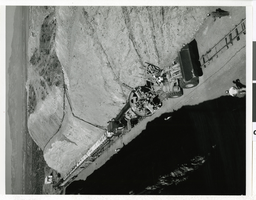
Photograph of the 988 caterpillar loader towing mole and conveyor to the tunnel portal used on the Las Vegas River Mountain Project, Las Vegas, Nevada, circa 1968-1971
Date
1968 to 1971
Archival Collection
Description
A front view taken from above of the outlet portal showing the 988 caterpillar loader towing mole and conveyor to the tunnel portal. The first stage of construction was completed between 1968-1971, and is comprised of a main aqueduct, a 3.78 mile tunnel through the River Mountains, eight pumping plants, and 31.4 miles of pipeline. This stage has a peaking capacity of 26.7 million cubic feet of potable water per day. The second stage enlarged the first stage system by expanding some of the existing facilities. New features included five pumping plants, the second barrel to the main aqueduct, and about 30 miles of pipeline and laterals with surge tanks, regulating tanks, and other delivery facilities. In conjunction with this stage, the State of Nevada enlarged and modified the Alfred Merritt Smith water treatment facilities to accommodate additional water supplies. The River Mountains Tunnel was constructed to full capacity in the first stage, and the Saddle Island intake facilities were oversized to accommodate both stages. The aqueduct system has a peaking capability of 53.4 million cubic feet of water per day. The River Mountains Tunnel was constructed during the first stage to accommodate second stage expansion. It is 3.78 miles long and was excavated through the River Mountains, which lie between Las Vegas Valley and Lake Mead. The concrete-lined tunnel has an inside diameter of 121.5 inches, and a maximum capacity of 608 cfs. The SNWA also constructed a larger tunnel, parallel to the River Mountains Tunnel for further expansion. The River Mountains Tunnel is used to convey raw water from Lake Mead to the River Mountains Water Treatment Facility that SNWA constructed near Henderson, NV. The River Mountains Facility, which began delivering treated water in October 2002, treats up to 300 million gallons of water per day, and was designed so it can expand to meet Southern Nevada's needs. In the future, the River Mountains facility will be able to treat up to 600 million gallons of water a day. This facility provides additional reliability and capacity to Southern Nevada's municipal water treatment and distribution capabilities.
Image
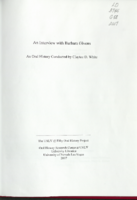
Transcript of interview with Barbara Givens by Claytee D. White, October 5, 2005
Date
2005-10-05
Archival Collection
Description
Barbara Givens was born in California, grew up in Reno, Nevada, and moved to Las Vegas in 1952 with her family when she was 14 years old. Her father ran a small construction business here in Vegas until he retired about 15 years ago. Her brother Steve and his children live in Vegas also. Barbara graduated from Las Vegas High School and enrolled in the first matriculated teacher's program at the Southern Regional Division of the University of Nevada at Las Vegas (now known as UNLV). Barbara was involved in organizing the first "Rebel Yell", school dances in Las Vegas, and other collegiate activities in Reno. In her senior year, she returned to Las Vegas High to complete her student teaching. After graduation, Barbara was assigned to Rancho High School to teach biology. She left after a year and a half because she had married and was expecting her first child. At that point in time, Clark County School District did not allow pregnant women to remain in the classroom. Fifteen years later she returned to the classroom, this time at Chaparral High. Concurrently, Barbara entered the Master's in Education program at UNLV, and graduated in 1980. Barbara has always loved to travel and has experienced many wonderful trips to exotic places around the world. In retirement, she assists with special events at Hamm Hall and Judy Bailey Theater, goes on-line to offer her services as a biology tutor to high school students, and continues to plan exciting trips abroad. She also indulges in her favorite hobby - attending Star Trek conventions and collecting Star Trek memorabilia.
Text
Determination of Equivalent Thermal Loadings as a Function of Waste Age and Burnup - Yucca Mountain Site Characterization Project, Sandia Laboratories, SAND87-2909, UC-814, 1991 March
Level of Description
File
Archival Collection
Yucca Mountain Site Characterization Office Collection
To request this item in person:
Collection Number: MS-00091
Collection Name: Yucca Mountain Site Characterization Office Collection
Box/Folder: Box 65, Box 69
Collection Name: Yucca Mountain Site Characterization Office Collection
Box/Folder: Box 65, Box 69
Archival Component
T-Shirt Color: Navy Blue; Front: Hoffman Estates Fire Dept. Squad 22, Dept. Emblem, approximately 2001-2012
Level of Description
File
Archival Collection
New York-New York Hotel and Casino 9-11 Heroes Tribute Collection
To request this item in person:
Collection Number: MS-00459
Collection Name: New York-New York Hotel and Casino 9-11 Heroes Tribute Collection
Box/Folder: Box 147
Collection Name: New York-New York Hotel and Casino 9-11 Heroes Tribute Collection
Box/Folder: Box 147
Archival Component
McDermott, Barry. College Basketball 1976-1977: everyone wants the net, Sports Illustrated 45(22), 1976 November 29
Level of Description
File
Archival Collection
UNLV Libraries Collection of Articles on Gaming and Las Vegas, Nevada Topics
To request this item in person:
Collection Number: MS-00626
Collection Name: UNLV Libraries Collection of Articles on Gaming and Las Vegas, Nevada Topics
Box/Folder: Box 14
Collection Name: UNLV Libraries Collection of Articles on Gaming and Las Vegas, Nevada Topics
Box/Folder: Box 14
Archival Component
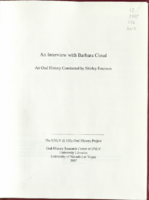
Transcript of interview with Barbara Cloud by Shirley Emerson, May 30, 2006
Date
2006-05-30
Archival Collection
Description
Barbara Cloud was born in Tulare, California. Her father's job kept the family on the move for the first seven years of her life. They eventually settled in Idaho Falls, Idaho, where Barbara attended grade school and high school. After graduation, Barbara applied to three universities and was accepted at all three. She chose Stanford and decided to major in journalism. It was while at Stanford that she also met and married her husband Stan. Stan and Barbara moved to California, where Barbara got a job working on a weekly Sunday supplement. After a year and a half, they returned to Oregon and Barbara decided to get her master's in journalism. She was given a graduate assistantship at the University of Oregon, and completed the degree in two years. In 1969, Stan agreed to accept a post doctoral assignment in Australia, and Barbara found a job with an advertising agency. After six years, the couple returned to Oregon, and Barbara decided to apply to the University of Washington for a PH.D. in journalism. She was admitted, given a graduate assistantship, and completed the work in three years. In 1978, Barbara applied for a journalism position at UNLV. She was hired, and she and Stan moved to Las Vegas in 1979. She built up the journalism program and continued with her research. In 1983, she became department chair, a position she was elected to each year for the next six years. She was the editor of "Journalism History", published her own book, and was associate provost for academic affairs. Barbara is retired today, though still connected with the School of Journalism. She is planning to teach a distance education course.
Text
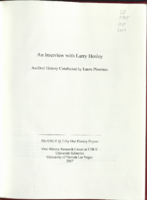
Transcript of interview with Larry Henley by Laura Plowman, May 23, 2007
Date
2007-05-23
Archival Collection
Description
Larry Henley was born in Portland, Oregon, in 1957. The family spent one year in Wisconsin, and then moved to Las Vegas in 1973 when he was 15. His schooling was mostly in Oregon, though he graduated from Chaparral High School in Las Vegas in Larry enrolled at UNLV in 1975 and was a student there off and on until 1980, the year he earned his theater degree. It wasn't until around 2002 that he got his master's. Mr. Henley started working at the concert hall at UNLV around 1977, doing lighting design work, then moved to Colorado Springs for three years. He opened the Pike s Peak Center, acting as stage manager and lighting technician, and eventually joined the stagehands' union. While in Colorado Springs, he was married, and he and his wife had a son. The Henleys moved back to Las Vegas so they could be closer to family, and Larry began working part-time on the stage crew at UNLV. He was listed as a classified employee, and this segued into a professional staff position in 1988. Today, Larry is the director of artistic programming and production at the Performing Arts Center. He schedules all performances in the theaters. He also does contracting and billing, works on the Master Series, and recruits speakers for the Barrick Lecture Series. He has made a 20 year career out of bringing entertainment and culture to the Las Vegas scene, continuing a tradition started by other directors.
Text
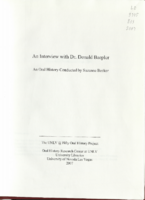
Transcript of interview with Dr. Donald Baepler by Suzanne Becker, April 23, 2007
Date
2007-04-23
Archival Collection
Description
Dr. Donald Baepler was born in Edmonton, Alberta, Canada in July of 1932. The family moved to Springfield, Illinois in 1936, where his father was president of Concordia Seminary. Donald decided at the age of seven that he wanted to pursue a Ph.D. in ornithology, not an unusual goal in his family. By the time he graduated high school, he knew that he wanted to attend Carlton College in Minnesota to study under Olin Sewall Pettingill. He followed world-famous ornithologist and artist George Sutton to Michigan and then to Oklahoma to complete his doctorate. In 1960, having completed his doctorate, Donald met with a recruiter from Las Vegas. It seemed like an intriguing place, so he took the interview and was offered a job on the spot. Instead, he took a job as professor of biology at Central Washington University, and within four years was vice president for administration and business. He had also been appointed to an accrediting team by the Northwest Association to accredit colleges in the western states, including Nevada Southern University in Las Vegas, and saw the growing town and university for the first time in 1965. Two years later, he was invited to take the job of Academic Vice President at SNU, which he accepted, and he and his family made the move to Las Vegas in 1968. Upon arriving in Las Vegas, Donald discovered that he had been named acting president because of Donald Moyer's abrupt resignation. He simply decided to do both jobs. He was successful in changing the name of the school to University of Nevada Las Vegas so that it would not be confused with a teacher's college. This was wholeheartedly accepted by the regents. Once Roman Zom was appointed president in 1969, Donald went back to the vice president position. In 1973, Dr. Baepler was appointed president of UNLV. He held that position for live years and then turned in his resignation. His intent was to teach, focus on a Museum of Natural History, and start a research center. Instead, he was offered the chancellorship of the university system, and he decided to accept the job By 1981, Donald was ready to return to teaching and research, so he resigned as chancellor and came back full-time as museum director and professor of biology. He built up a high-hazard chemistry lab and got the grant monies to sustain it. Dr. Baepler was also influential in adding the Harry Reid Center to the museum. Today Dr. Baepler is still involved with the bird program and gives advice to graduate students, but he no longer teaches. He stays occupied with a private consulting business.
Text
Pagination
Refine my results
Content Type
Creator or Contributor
Subject
Archival Collection
Digital Project
Resource Type
Year
Material Type
Place
Language
Records Classification
